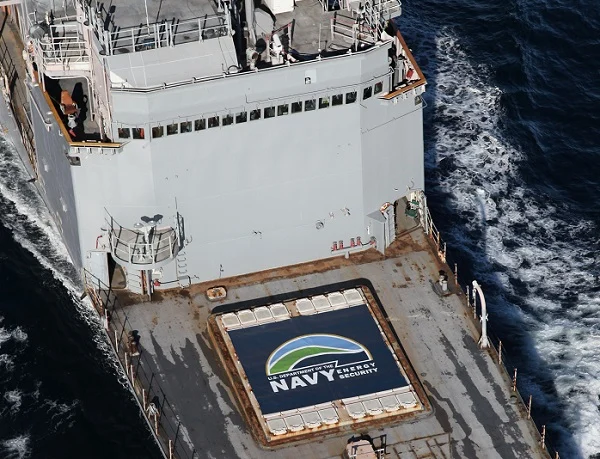The U.S. Navy has faced resistance from many conservatives in its quest to use advanced biofuels to power its ships and planes, but maybe putting a “homegrown” spin on the move – with a program called “Farm to Fleet” – will help quiet the critics.
The program, according to the Obama administration, is actually more than an alliterative, red-state-friendly name. Farm to Fleet will, the U.S. Department of Agriculture and the Navy said on Wednesday, allow the Navy to “make biofuel blends part of regular, operational fuel purchase and use by the military.” The ultimate goal, the Navy said, is to have a secure, stable fuel source, guarding against oil price spikes.

in late 2011, this Self Defense Test Ship – the decommissioned Spruance-class destroyer Paul F. Foster, reconfigured to provide an unmanned test platform – made a 17-hour trek from San Diego to the Naval Surface Warfare Center Port Hueneme using a 50-50 blend of algae-derived, hydro-processed oil and a standard petroleum fuel. (image via U.S. Navy)
“A secure, domestically-produced energy source is very important to our national security,” Navy Secretary Ray Mabus said in a statement, while Ag Secretary Tom Vilsack said “rural America stands ready to provide clean, homegrown energy that increases our military’s energy independence and puts Americans to work.”
The fuels – made variously from crops like soybeans, or algae or even from cooking grease – will no longer be special, one-off purchases. They’ll be bulk buys, with the first solicitation expected next year for delivery in 2015.
And will the prices be anywhere near the $26-a-gallon figure that raised hackles a couple of years ago?
Way lower, the USDA said: “Preliminary indications from the Defense Production Act Title III Advanced Drop-in Biofuels Production Project are that drop-in biofuels will be available for less than $4 per gallon by 2016, making them competitive with traditional sources of fuel.”
That seems like an amazing leap, but Assistant Secretary of the Navy for Energy, Installations and Environment, Vice Admiral Dennis McGinn (USN, Ret.) told Biofuel Digest it’s going to happen.
“We are not going to pay a premium,” McGinn said. ““But we are going to expand the types of liquid fuels that the Navy is going to use. By reducing our dependence on a single fuel source, in the long-term we are going to protect the Navy from price volatility and increase our combat effectiveness.”
A key to making it possible will be that some of the blends will apparently have just a small amount of biofuel in them. With the Navy allowing blends from jet fuel (JP-5) and marine diesel (F-76) with a biofuel component anywhere from 10 to 50 percent, “Individual bidding companies will be able to determine, based on their own costs and capacities, how much of a biofuels component to include,” Jim Lane reported in Biofuels Digest.






